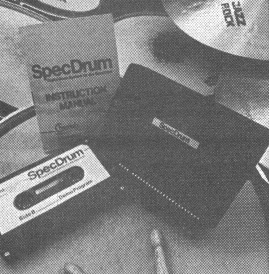Cheetah Specdrum
The following review
was taken from Popular Computing Weekly October 1985

anyone have a better (colour) pic?
Cards on table time. I am biased towards all
things musical on micros because it seems to me to be one of the genuinely fun things
micros can do.
Whereas it is now quite cheap to get yourself a useful little Casio keyboard, the
pre-set drum sounds are usually useless. Almost without exception drum sounds on the cheap
keyboards are so irredeemably Neanderthal, idiotic and plastic sounding that only those
people whose ultimate objective in musical life is to play When the Saints Go Marching
In, will find it satisfactory.
Conversely, though, decent drum machines can, cost you £300 plus.
Cheetah has now produced an answer. Specdrum gives you, in conjunc-tion with a
Spectrum, an excellent drum machine that uses sampled sounds (real drums digitally
encoded) which can be played either in real time or notated using a simple screen editing
system.
The Specdrum system comes with a 'kit' of eight sounds bass drum, high hat open,
high hat closed (chik and toosh respectively) hand claps (shak), snare (thwak) cowbell
(ching), mid tom (thom), low tom (domp) and hand claps (krkkkk). Up to three of these
sounds can be used simultaneously but in fact the illusion of everything happening at once
is quite possible with a bit of smart programming around the beat.
The software that gives you control of all this is mainly excellent. The display
lets you choose a song to work on and name it, starting either from scratch or loading in
saved drum patterns from tape. Composing a song (which means an ordered sequence of
different patterns) is a matter first of crating the individual drum sections then
structuring the completed patterns according to the layout of the music you want to use
them with.
The pattern creation section works in two ways. You can either work in real time,
choosing and inserting each different percussive beat and building up a complete pattern
over a specified number of bars or you can enter each beat using cursor keys on a
simplified equivalent of a musical stave.
The excellent part of all this is that the real time and notation ways of working
are completely interrelated - your real time drum inputs are automatically notated for you
so it is possible to mix the different kinds of inputs easily. This means that the
easy-to-play bits like a regular snare pulse can be quickly tapped out in real time and
some tricky twiddly bits car be carefully notated.
The individual patterns are then 'filled' and numbered and then Saved to tape.
The only criticism I have of the software is that there are some occasions where
you go into sub menus and discover that options that are not currently available stay on
the screen, eg, often option D for drum play is shown, but pressing D won't do anything
until you have 'returned' from some sub menu. It's basically a small point.
The sounds are excellent and it does help if you have a decent amp or hi fi. You'll
will need some sort of amplifier whatever you do though - the Specdrum sends its sound
signal out via a standard phono lead.
There is promise by Cheetah too, of other sounds on tape for around £3 to give you
a totally different kind of drum section.
You can, even synchronise your Specdrum to other instruments - it will produce a
click impulse into the Spectrum Mic socket. This pulse - put into a multitrack or on to
tape could form a click track to trigger Sequencers but the manual is unfortunately very
vague On this point. I think you'd need a sync box tough - the manual is not helpful on
this point and I'd have welcomed a lot more information.
This peripheral should be treated with unrestrained glee by Spectrum owning music
buffs.
A decent drum machine for £29.95? Ridiculous! |
